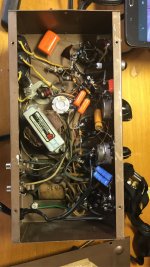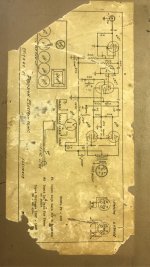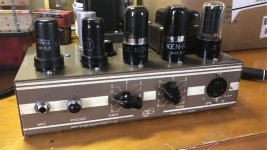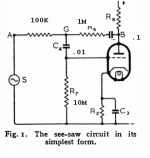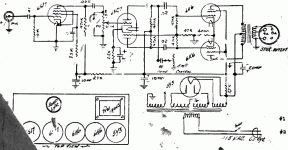Hey guys, I have an precision electronics PA amplifier that I've converted for guitar use. It has a grid leak bias 6sj7 for the first gain stage. Then it uses a 6sc7 for a phase inverter and drives two 6K6's. The amp sounds great but it has very little headroom.
Is there a way that I can lower the gain on the grid leak bias 6sj7? The plate voltage is about 80v. There is a 10meg resistor from the input grid to ground. There is a .1 cap from G2 to ground. G2 is fed voltage through a 3.3meg resistor.
Any Ideas?
Is there a way that I can lower the gain on the grid leak bias 6sj7? The plate voltage is about 80v. There is a 10meg resistor from the input grid to ground. There is a .1 cap from G2 to ground. G2 is fed voltage through a 3.3meg resistor.
Any Ideas?
No so. In a pentode, gain is apx. gm * Rl, independently of plate voltage. Gm is mainly governed by screen (g2) and control grid (G1) biases. So reducing plate load resistor effectively will raise anode voltage, without any future complication.
Noy I saw that you use grid leak, so the 10MΩ is good, but limit maximum input signal below a volt.
Noy I saw that you use grid leak, so the 10MΩ is good, but limit maximum input signal below a volt.
Last edited:
I haven't tried that. The amp had a phono input that bypassed the 6sj7 and entered the phase inverter stage through the volume control. I removed this input. I suppose there would be considerably less distortion if the guitar signal took this path. But I didn't like the idea of a guitar amp with only a phase inverter for a gain stage.
OK, there must not be a problem going directly to phase splitter, from a theoretical point of view. Another thing you can do, is trying to feedback the 6SJ7 stage, as follows. Add a .01µF 400V in the grid circuit, if it hasn't any. Then, add a .1µF from plate to an isolated point in the chassis. From this point, add a 1MΩ resistor to the grid capacitor above mentioned, but in the other lead. Add still another resistor of say, 100KΩ, and take the input to the circuit from the remaining 100KΩ lead. This way, you build a "see Saw" amplifier. Modifying the 100KΩ value, you will modify the gain, as:
AV ≈ - 1MΩ/100KΩ = -10 times.
The minus sign signifies phase reversal, which doesn't care in your case.
AV ≈ - 1MΩ/100KΩ = -10 times.
The minus sign signifies phase reversal, which doesn't care in your case.
The negative feedback in #12 reduces input impedance (or raises hiss voltage).
The most obvious "fix": there's a knob on the guitar which turns it down. Use it.
Sensitivity at driver is about 0.4V. While you report your guitar has that, guitarists usually want more gain than that. Worth a try. Will probably be "hard work" to get maximum power.
Old microphones were much weaker than modern guitars. The 6SJ7 gives gain of 100, but never expected even 100mV input. A benchmark target gain for this stage for general guitar use might be 20. Also a plate voltage which isn't slammed, so it will take large inputs.
There IS a reason some early guitar amps used grid-leak then shifted to cathode-bias mid-1950s. Guitars are stronger than grid-leak.
You can triode-strap the 6SJ7 with cathode bias and get a gain about 16. Use 470K or 270K RP, snip 0.1u, strap G2 to P, add 1K RK, shunt 1Meg across the 10Meg, and optionally short-out the 0.01u cap. Like that is gain of maybe 8. Be prepared to add 10u across RK for gain of 16, but you may not need it.
Or consider re-connecting for a hi-Mu triode. In octal, 6SC7 is a classic, and you already have one. As a 1st stage, just use one side. You can steal RP and RK from any 12AX7 plan (close enough); or steal from the PE's 2nd stage RP=470K, Rk=3.9K (for one). A single hi-Mu Octal is the obscure 6K5, sells for $7. Need a top-cap clip.
> raise the plate voltage, thereby reducing the gain
No, not at all. To over-simplify, pentode gain is proportional to RP (as Osvaldo said), so this "should" have cut gain nearly in half. However I am thinking the higher plate voltage also shifted the grid-leak value, more current, higher Gm. And if we go too far, max output swing is limited again (but on top not bottom). An alternate is to raise the G2 voltage. However optimizing a pentode is a 3-way dance, and it is easy to find values which just do not work too good. Grid-leak adds another complicarion.
The most obvious "fix": there's a knob on the guitar which turns it down. Use it.
Sensitivity at driver is about 0.4V. While you report your guitar has that, guitarists usually want more gain than that. Worth a try. Will probably be "hard work" to get maximum power.
Old microphones were much weaker than modern guitars. The 6SJ7 gives gain of 100, but never expected even 100mV input. A benchmark target gain for this stage for general guitar use might be 20. Also a plate voltage which isn't slammed, so it will take large inputs.
There IS a reason some early guitar amps used grid-leak then shifted to cathode-bias mid-1950s. Guitars are stronger than grid-leak.
You can triode-strap the 6SJ7 with cathode bias and get a gain about 16. Use 470K or 270K RP, snip 0.1u, strap G2 to P, add 1K RK, shunt 1Meg across the 10Meg, and optionally short-out the 0.01u cap. Like that is gain of maybe 8. Be prepared to add 10u across RK for gain of 16, but you may not need it.
Or consider re-connecting for a hi-Mu triode. In octal, 6SC7 is a classic, and you already have one. As a 1st stage, just use one side. You can steal RP and RK from any 12AX7 plan (close enough); or steal from the PE's 2nd stage RP=470K, Rk=3.9K (for one). A single hi-Mu Octal is the obscure 6K5, sells for $7. Need a top-cap clip.
> raise the plate voltage, thereby reducing the gain
No, not at all. To over-simplify, pentode gain is proportional to RP (as Osvaldo said), so this "should" have cut gain nearly in half. However I am thinking the higher plate voltage also shifted the grid-leak value, more current, higher Gm. And if we go too far, max output swing is limited again (but on top not bottom). An alternate is to raise the G2 voltage. However optimizing a pentode is a 3-way dance, and it is easy to find values which just do not work too good. Grid-leak adds another complicarion.
Attachments
Grid leak bias is completely unsuitable for guitar amps. You need to convert that to a cathode biased stage, with a 1M or 470k grid reference resistor to ground.
One other thing about 6SJ7s, is they will still develop a DC voltage at the grid, which will make your guitar pots go noisy. The fix for this is to place a 0.1uF cap between the grid and input jack.
Sent from my phone. Please excuse any typpos.
One other thing about 6SJ7s, is they will still develop a DC voltage at the grid, which will make your guitar pots go noisy. The fix for this is to place a 0.1uF cap between the grid and input jack.
Sent from my phone. Please excuse any typpos.
I suppose there would be considerably less distortion if the guitar signal took this path. But I didn't like the idea of a guitar amp with only a phase inverter for a gain stage.
That's correct. For a guitar amp you need at least one gain stage before the PI. Overall the less you change this amp the better. The one input that any straight to the PI would have been for a record deck with a ceramic or piezzo tranducer, which have a very high output relative to a guitar pickup. FYI I used to design just amps for my day job.
Also what have you got against distortion? I know tastes vary, but it seems a shame to have a board amp that won't distort at all. Typically, the aim is to have clean/distortion tones that can be controlled by the guitar volume control as well as how you pick the strings.
Sent from my phone. Please excuse any typpos.
Last edited:
I would also strongly recommend all suggestions to triode strap or place NFB around the 6SJ7, as the non linearity of these pentodes provided a really sweet guitar tone, that would be a huge shame to lose. I recommend checking out Valve Wizzard Merlin's page on how to design pentode gain stages, to set the gain level to what you actually want, while preserving the pentode tone.
Sent from my phone. Please excuse any typpos.
Sent from my phone. Please excuse any typpos.
Grid leak bias is completely unsuitable for guitar amps.
I don't know any about musical instruments and their amplifiers, but if the signal output is below the volt, and the guy said .5V, and taking into account that grid leak usually gives a bias of -1 to -1.5V, I can't see why not to use the bias as it is. Perhaps you can teach me about this fact.
Kind regards.
Guitar pickups vary greatly, and have different output levels (and we must also allow for transients when the strings are picked hard). Then we also need to allow for the effects pedals that many guitarists use. So in this specific case the OP might get away with the grid leak bias (make sure no carbon comp resistors are used) However, it is generally considered to not be good design practice for guitar amps.
Sent from my phone. Please excuse any typpos.
Sent from my phone. Please excuse any typpos.
- Status
- This old topic is closed. If you want to reopen this topic, contact a moderator using the "Report Post" button.
- Home
- Live Sound
- Instruments and Amps
- 6sj7 grid leak bias- lower gain
